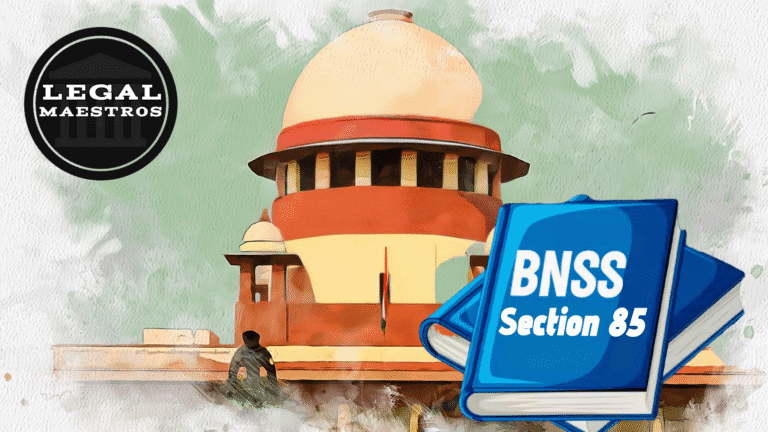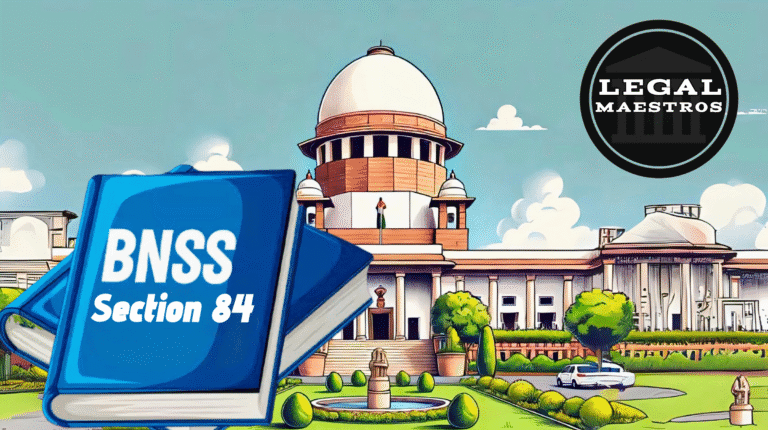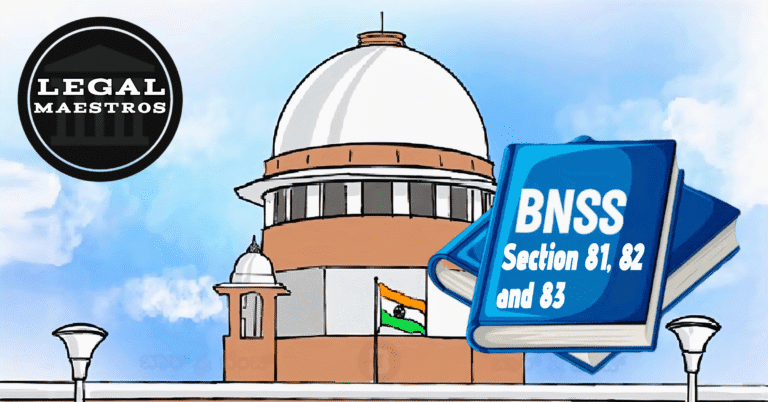
Section 50: Power to Seize Offensive Weapons
The police officer or any other person who makes an arrest in accordance with the Bharatiya Nagarik Suraksha Sanhita, 2023 is granted specific authority by this clause. Once a person is arrested, the officer or person initiating the arrest has the legal authority to remove any offensive weapon that the apprehended individual could be carrying. This is in accordance with the clause.
What is meant by the term “offensive weapon” is any thing that has the potential to cause hurt, injure, or create a threat to other people. Depending on the specifics of the situation, these may include firearms, knives, implements with sharp edges, or even dull things that are hefty.
The fundamental purpose of this rule is to guarantee the safety of the general public and to make the setting in which arrests are made more secure. When someone is being detained, they should not keep any dangerous items in their possession that could cause harm to the cops who are arresting them, bystanders, or even the person who is being arrested themselves.
For any queries or to publish an article or post or advertisement on our platform, do call at +91 6377460764 or email us at contact@legalmaestros.com.
Following the seizure of such weapons, the law makes it abundantly plain that you are required to hand over all of these items to the appropriate authority. In accordance with the Sanhita, this authority may be the court or the officer who is responsible for bringing the individual who was arrested before them. This not only helps to prevent any misuse or misplacement of evidence, but it also ensures that the goods that have been seized have a documented chain of custody.
Example of Section 50 in its entirety
Imagine that a law enforcement officer makes an arrest of a person who is accused of committing a violent robbery. It was discovered that the suspect was carrying a loaded weapon that was concealed within his waistband when he was taken into custody. In accordance with Section 50, the officer is authorized to promptly seize the pistol from the suspect immediately. When the officer has finished securing the weapon, he or she is required to hand it over to the magistrate or police officer who will be presenting the accused against them. Because of this, both safety and legal accountability are guaranteed.
Section 51: Examination of Accused by Medical Practitioner at the Request of Police Officer
Under the circumstances that are outlined in Section 51, a law enforcement officer has the authority to request that a registered medical practitioner administer an examination to a person who has been arrested. When the crime is of such a type and has allegedly been committed under such circumstances, that inspecting the body of the accused could offer vital evidence regarding the commission of the crime, then this examination is permissible under the law.
For any queries or to publish an article or post or advertisement on our platform, do call at +91 6377460764 or email us at contact@legalmaestros.com.
Legal Justifications for a Medical Examining Itself
It is necessary to have “reasonable grounds” for believing that evaluating the individual will assist in the discovery of evidence in order for a medical examination to be conducted in accordance with this clause. By using this term, you can rest assured that examinations will not be carried out arbitrarily or without a valid reason. A belief that is founded on factual circumstances, as opposed to a simple suspicion, must be the source of the request.
Given the provisions of this section, the examination can be carried out by the registered medical practitioner. Additionally, the law acknowledges the possibility that the medical practitioner may require assistance. Consequently, any individual who is acting in good faith and following the doctor’s instructions is also permitted to assist in the examination by the doctor.
Applying Force That Is Reasonable
In addition, the rule makes it abundantly apparent that the medical examination may be carried out with the application of force that is considered to be appropriate. The term “reasonable” is significant because it marks the limit of the amount of force that can be used as well as the sort of force that can be applied. In other words, the use of force should be limited to the level that is required to carry out the examination, and it should not grow excessive or abusive throughout the process.
For any queries or to publish an article or post or advertisement on our platform, do call at +91 6377460764 or email us at contact@legalmaestros.com.
Investigation of a Female Accused Individual
Regarding the examination of a female accused person, Section 51 contains a very essential protection that is attached to it. It is required that the examination be carried out solely by a female certified medical practitioner or under the supervision of a female medical practitioner when the person who is being arrested is a female. In the course of the examination, this rule guarantees that women will maintain their dignity and continue to maintain their modesty. Additionally, it safeguards the accused woman against any potential exploitation or harm that may occur during the medical examination.
Illustration for the Female Alleged Offender
In the event that a woman is detained for alleged involvement in a poisoning case and a blood test is required to confirm the presence of poisonous substances, the police are not permitted to permit a male physician to carry out the treatment unless it is being carried out under the supervision of a female medical expert. This increases the level of protection afforded to women who are detained.
Providing the Report in a Timely Manner
The law requires that the examination report be sent to the investigating officer without any delay. This is a requirement that the registered medical practitioner must fulfill. In order to keep the chain of investigation intact and to make certain that no time is wasted in the process of obtaining and evaluating essential evidence, this phrase is absolutely necessary.
For any queries or to publish an article or post or advertisement on our platform, do call at +91 6377460764 or email us at contact@legalmaestros.com.
It is also helpful to avoid any claims of evidence tampering or undue delay, both of which could undermine the prosecution’s case or postpone justice. Prompt reporting helps avoid these claims.
A clarification In accordance with Section 51 Section 51 includes an explanation that provides additional clarification on the meaning of terms that are utilized in the particular section as well as in the subsequent sections 52 and 53. Understanding the technical extent of “examination” and “registered medical practitioner” is made much easier by this explanation, which plays a critical role in the process.
“Examination”: What Does It Mean?
In accordance with the law, the term “examination” encompasses a wide range of medical examinations and the collecting of samples. Blood, blood stains, sperm, swabs in situations of sexual offenses, sputum, perspiration, hair samples, and fingernail clippings are all examples of the kind of samples that can be tested from this. In addition, the law permits the utilization of contemporary and scientific methods, such as DNA profiling and other essential examinations that the medical practitioner may deem relevant in a particular instance.
For any queries or to publish an article or post or advertisement on our platform, do call at +91 6377460764 or email us at contact@legalmaestros.com.
Because of the expansive nature of this definition, it guarantees that the medical professional have the legal authority to carry out a variety of forensic and medical investigations that could potentially assist in revealing the truth. Additionally, it is in accordance with contemporary methods of criminal investigation, which guarantees that the legal system is able to keep up with the breakthroughs in scientific knowledge.
Exemplification of the Examination
In the event of a rape investigation, it is possible to collect swabs from the body of the accused in order to compare their DNA with samples taken from the victim. In a similar manner, nail scrapings may be taken in the event of a physical assault in order to examine the victim’s skin or the presence of blood beneath the fingernails of the charged individual. When it comes to determining guilt or innocence, these examinations are absolutely necessary.
An explanation of what “Registered Medical Practitioner” describes.
When referring to a medical practitioner, this phrase is used to describe someone who has obtained a qualification that is recognized by the National Medical Commission Act, 2019. In addition, in accordance with the provisions of the Act, the medical practitioner is required to have their name listed in either the National Medical Register or a State Medical Register.
For any queries or to publish an article or post or advertisement on our platform, do call at +91 6377460764 or email us at contact@legalmaestros.com.
Therefore, the examinations that are detailed in this section are only authorized to be carried out by individuals who possess credentials that are recognized and who have a registration that is still active. In this way, examinations are guaranteed to be carried out by specialists who are both knowledgeable and authorized by the law.




![Research Assistantship @ Sahibnoor Singh Sindhu, [Remote; Stipend of Rs. 7.5k; Dec 2025 & Jan 2026]: Apply by Nov 14, 2025!](https://legalmaestros.com/wp-content/uploads/2025/11/Gemini_Generated_Image_s0k4u6s0k4u6s0k4-768x707.png)
![Karanjawala & Co Hiring Freshers for Legal Counsel [Immediate Joining; Full Time Position in Delhi]: Apply Now!](https://legalmaestros.com/wp-content/uploads/2025/11/Gemini_Generated_Image_52f8mg52f8mg52f8-768x711.png)
![Part-Time Legal Associate / Legal Intern @ Juris at Work [Remote]: Apply Now!](https://legalmaestros.com/wp-content/uploads/2025/11/ChatGPT-Image-Nov-12-2025-08_08_41-PM-768x768.png)
![JOB POST: Legal Content Manager at Lawctopus [3-7 Years PQE; Salary Upto Rs. 70k; Remote]: Rolling Applications!](https://legalmaestros.com/wp-content/uploads/2025/11/ChatGPT-Image-Nov-12-2025-08_01_56-PM-768x768.png)
1 thought on “Sections 50 & 51 – Bharatiya Nagarik Suraksha Sanhita, 2023: Seizure of Offensive Weapons and Medical Examination of the Accused”